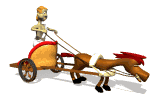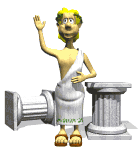| Links
|
Life in
Ancient Rome
|
vocabulary |
unit plan | Student Activity |  |
ROME

WHAT DO WE CALL THE ROMAN EMPIRE?
- A territory.
An empire is an extensive territory under the same government. The Roman Empire was a territory conquered by the city of Rome around the Mediterranean Sea between the 4th century BC and the 2nd century AD.
The River Tiber forms a meander near its mouth, around seven hills. These hills were inhabited in the 8th century BC by seven villages located on the highest areas to protect themselves from floods. Its location in the centre of Italy and the trading routes between the north and the south of the Italian Peninsula were strategic.
The Etruscans, a people from the centre of Italy, conquered the seven hills in the 7th century BC. This is the origin of Rome and the Roman Empire.
The Roman Empire has three stages. During the period of Etruscan influence, Rome was a monarchy ruled by a king assisited by a senate. Later, the Romans threw out the Etruscan monarchs and established the republic. But the corruption finished with this system of government and the empire began.
ACTIVITIES
1.- What is the historical origin of Rome?
2.- Do you know any other civilization that was founded near the river?
3.- Who were the Etruscans?
4.- What are the stages of the Roman Empire?
5.- Look at the map and describe the boundaries:
List the territories that the Roman Empire dominated.
What rivers marked the northeastern border of the empire?
What seas bordered on the Roman Empire?
Which stage did the greatest conquests occur in?
Write down which of the following current countries were part of the Roman Empire: United Kingdom, France, Spain, Finland, Portugal, Italy, Tunisia, Egypt, Lebanon and Denmark.
WHAT HAPPENED DURING THE MONARCHY AND THE REPUBLIC ?
- The Etruscan monarchy.
In the beginning, Rome was ruled by seven kings. The last monarchs were Etruscans. The king was assisted by a Senate, an assambly were only the noble families were represented. In this period Rome became a great city and the people from the centre of Italy emigrated there.
The settlers didn't accept the the authorities of the Etruscans and for this reason, the Romans threw out the Etruscans monarchs and established the republic in 509 BC.
- The republic: a period of conquests.
During the republic the citizens met in assamblies called comitia, to pass laws and to elect the different magistrates who were responsible for government.
Roman society was a deeply unequal society. This society was divided into three large groups:
- The patricians were the owners of most of the lands and herds. They participated in the Senate and occupied the highest political and military positions.
- The plebeians were thw foreigners, immigrants, small land owners, traders, framers and craftmen. They were the largest group. At first they couldn't participate in politics, but later they got the right to vote.
- The slaves, who were prisoners of war or sons and daughters of other slaves, did not have rights. They were not considered people. They could buy their freedom and become freedmen.
ACTIVITIES
1.- How was the Roman society organised in the republican period?
2.- Which groups had rights and which did not?
3.- Explain the differences between the government during the monarchy and the republic.

WHAT WAS LIFE LIKE DURING THE EMPIRE?
- A period of peace.
The peace of the empire was guaranteed by a professional army. The emperor was the head of the army that was strongly hierarchical and disciplined. It was organised into legions made up of legionaries.
- A period of prosperity.
Peace favoured production and trade between the provinces of the empire. The Roman administration made a complete collection of public services available to the inhabitants of the empire: aquetucts to carry water, roads, baths, etc.
Prosperity promoted art and literature. The best Roman poets wrote in the time of Augustus, those poets were Virgil, Horace and Ovid.
- A divided society.
In the 2nd century AD there were around 50 million inhabitantsb in the Roman Empire. There were two groups : Citizens and non-citizens. Citizens were people who had all rights: They could own property, go to trial, vote, and they even had the right to get married.
Women didn't have all those rights. They were kept by a man and excluded from political life, but they could own property, run a businesses and participate in public activities and parties.
Roman society during the empire
Emperor
Rich people Roman citizens free men slaves Senators and Kights
Sons of citizens, free men of Italy,
Imperial decision, military service.
Inhabitants of the provinces and Freedmen. Sons of slaves, condemned people and prisoners of war.
WHY DID THE ROMAN EMPIRE GO INTO CRISIS?
- A threatened empire in the 2nd century.
In the 2nd century, the Roman Empire went through a serious military, political and economic crisis.
- The Germanic peoples, called"barbarian"by the Romans, which means "who live outside the borders of the empire", applied pressure from the north.
- The Persians applied pressure from the east.
At the same time,the figure of the Emperor weakened: many emperors died in combat or were muredered by military men.
Trade was affected by lack of security. Taxes increased, the richest people left the cities in search of security. Thr poor also moved to the country, were provisions were easier to find. A phenomenon of ruralisation occurred.
Learn about life in Ancient Rome
Geographic features Government Agriculture Architecture Music Art and entertainment Religion Sports Roles of men, women and children


